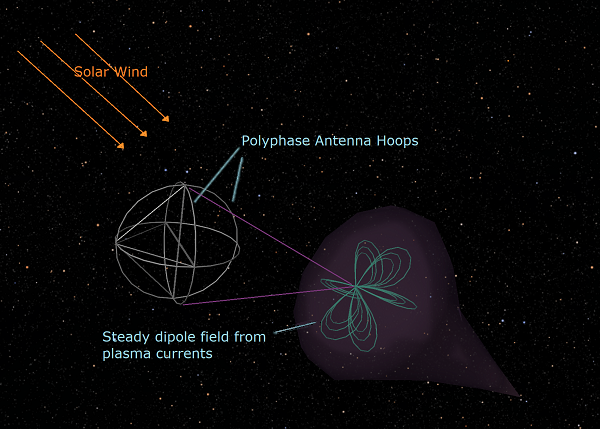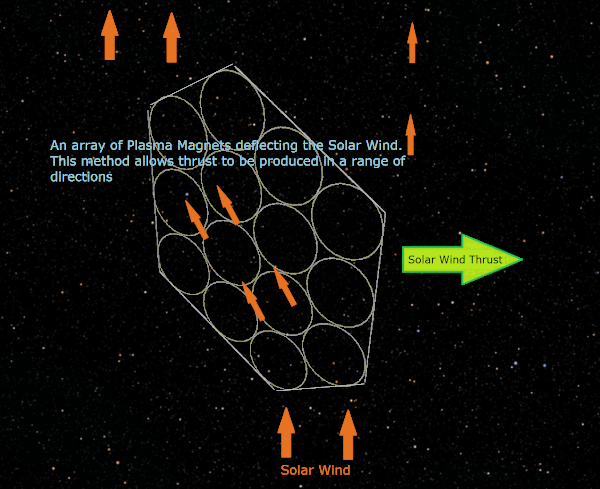BY LETTER
Plasma Magnet Drive
Technology > Application > Transportation > Interplanetary Transport
Technology > Application > Transportation > Interstellar Transport
Technology > Application > Transportation > Propulsion Technology
Technology > Application > Transportation > Ships
Technology > Application > Transportation > Interstellar Transport
Technology > Application > Transportation > Propulsion Technology
Technology > Application > Transportation > Ships
 Image from Steve Bowers | |
| Plasma magnets can create large-scale magnetic fields, useful in various applications | |
The core structure of a plasma magnet consists of two pairs of charged, rotating coils (also referred to as antennas). These generate a rotating magnetic field which traps the stellar wind, creating a large ring current and thus a large-scale magnetosphere. Any thrust applied to the magnetosphere, such as from the stellar wind, is transmitted to the plasma magnet via the magnetic field, similar to the coupling of rotation in an electric motor.
The size of a plasma magnet-generated magnetosphere is negatively proportional to the stellar wind density. When the stellar wind density decreases (as occurs when moving further away from a star), the magnetosphere expands. As a result, a plasma magnet experiences constant thrust regardless of its distance from the star it orbits.
The principle advantage of the plasma magnet is its ability to form an enormous magnetic field using a relatively small device. Even a small, Information Age plasma magnet with coils 10 centimetres in diameter could produce a magnetosphere with a diameter of 30 kilometres. Modern plasma magnets, using larger coils made of advanced superconductors and powered by fusion or conversion reactors, can reach diameters in the thousands of kilometres.
While plasma magnets have various useful applications, particularly as a form of propulsion, they have two notable disadvantages when used as spacecraft drives. First, a single plasma magnet can only produce thrust away from a star: it cannot deflect the stellar wind at an angle like a solar sail or a conventional magnetic sail to produce thrust in other directions. This makes it only useful for accelerating outbound spacecraft or decelerating incoming vessels. However, this can be solved by using an array of plasma magnets, which can deflect the stellar wind at an angle. Second, a PMD that is driven solely by stellar wind is unable to greatly exceed the speed of the stellar wind* (measured in tens to thousands of kilometres/second, depending on the star and the spacecraft's position relative to it). This speed is adequate for interplanetary travel, but it is less suitable for interstellar journeys.
Many spacecraft use one or more arrays of PMDs as a primary or secondary drive system. These are often used to allow the spacecraft to be propelled by boostbeams, a method that overcomes the direction and maximum speed limitations of a PMD operating in isolation. Spacecraft transporting cargo that is not particularly urgent will often rely on the stellar wind alone for propulsion, reducing the burden on the boostbeam generators. Plasma magnet drives propelled by the stellar wind can offer thrust-to-weight ratios one or more orders of magnitude greater than ion drives or solar sails. While this is still lower than, (for example) a fusion rocket expelling reaction mass, PMDs have the advantage of not requiring any onboard reaction mass (since they use the stellar wind for this purpose).
Certain planets have a plasma torus revolving around them at high speeds. An example of this is Jupiter in Solsys, where it is created by the planet's rapid rotation and volcanic activity from the moon Io. Such plasma tori are useful for PMD-equipped spacecraft. If a spacecraft flies into a torus in the opposite direction to the plasma's flow, it will be slowed down (usually used to enter orbit around the planet). Conversely, a spacecraft can ride the plasma torus away from the planet on a starward trajectory.
 Image from Steve Bowers |
Asteroid redirection: An array-based PMD can be attached to an asteroid to redirect it into a specific orbit, where it can be mined more easily. Additionally, it is possible to attach a long tether to an asteroid being mined, forming a rotovator which PMD-equipped spacecraft can then use. A PMD-equipped spacecraft on an outbound trajectory can dock with the end of the tether, pick up a payload of ore mined from the asteroid, then be swung by the tether onto an inbound trajectory; this is an alternative way to overcome the directional limitations of PMDs. However, using a tether constrains the spacecraft to relatively low speeds, to avoid over-stressing it.
In addition, asteroids on trajectories that could potentially lead them to strike inhabited worlds can be redirected by attaching a PMD to them. This is fuel-efficient and (with a single plasma magnet) provides thrust in a constant direction regardless of the asteroid's rotation.
Radiation shielding: The magnetosphere generated by a plasma magnet can stop charged particle radiation. However, it is not effective against neutrons or electromagnetic radiation (e.g. gamma rays). For long-term use, plasma magnet shielding must be supplemented by other forms of shielding and/or any passengers (or inhabitants, in the case of habitats) must be radiation-tolerant.
Aerobraking and landing: This involves the use of a dipole magnet, essentially a plasma magnet with non-rotating coils that produces a smaller magnetosphere and also requires the injection of gram quantities of plasma into said magnetosphere. When this magnetosphere contacts the atmosphere of a world, it traps the neutral atmosphere molecules and produces intense (kilonewton-level) drag. This allows propellant-less re-entry and descent on any world with an atmosphere, without needing a heavy heat shield (although an additional form of propulsion is needed for atmospheric flight and/or controlled touchdown).
Spacecraft that are designed for both interplanetary and surface-to-orbit transport have a plasma magnet that can double as a dipole magnet (by stopping its rotation), while spacecraft designed only for surface-to-orbit transport have just a dipole magnet system.
- Using an array, it is possible to travel at an angle to the stellar wind and therefore achieve somewhat higher speeds, similar to how a sailing ship can travel faster than the wind by sailing at an angle to it.
Related Articles
Appears in Topics
Development Notes
Text by Tardigrada
Initially published on 26 June 2021.
7th paragraph Update added 22 December 2023 by Tardigrada
References:
The Plasma Magnet Drive: A Simple, Cheap Drive for the Solar System and Beyond - Alex Tolley
Initially published on 26 June 2021.
7th paragraph Update added 22 December 2023 by Tardigrada
References:
The Plasma Magnet Drive: A Simple, Cheap Drive for the Solar System and Beyond - Alex Tolley






